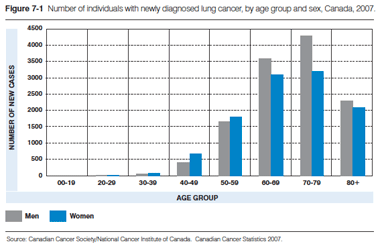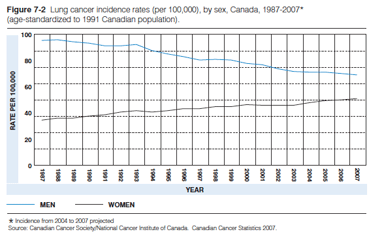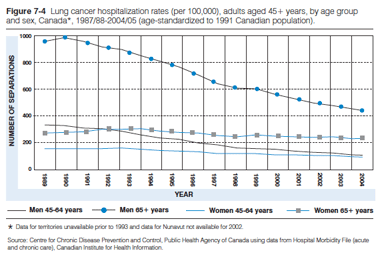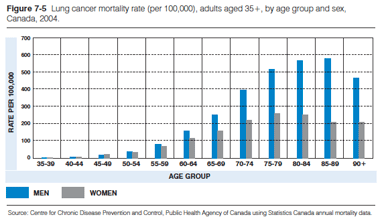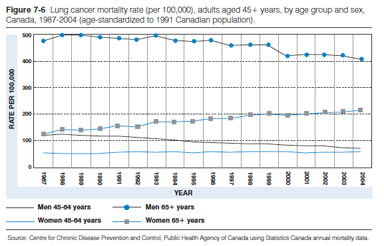Lung Cancer
Introduction
Lung cancer is the leading cause of death due to cancer in Canada. It causes approximately 29% of cancer deaths among men and 22% among women. Treatment consists of various combinations of surgical resection, chemotherapy and radiotherapy. Five-year survival rates are quite high for individuals with localized non-small cell lung cancer tumours.1 Unfortunately, only a small proportion of lung cancer is localized at the time of diagnosis. Prognosis for individuals with small cell lung cancers is generally poor. No tests or techniques are yet universally accepted for the detection of lung cancer at an early enough stage for intervention to improve the course of the disease. Therefore, screening is not routinely performed for early detection of lung cancer.
Risk Factors
Smoking
Cigarette smoking is the predominant cause of lung cancer. It accounts for at least 80% of all new cases of lung cancer in women and 90% in men.2 Risk rises sharply with an increase in number of cigarettes smoked per day, and still more with an increase in number of years of smoking.3, 4 Quitting smoking can prevent further increases in the risk of lung cancer, but the risk among former smokers remains higher than that for lifetime nonsmokers.5, 6
A few recent studies7, 8 have explored whether there might be an elevated risk of lung cancer among those who start smoking earlier in life, independent of duration and amount smoked. The evidence is inconclusive. Further research is required to better understand this possible link.
Pipe and cigar smoking are also linked to lung cancer but each carries smaller risks than for cigarette smoking, possibly due to different inhalation patterns.9, 10
Environmental Factors
Second-hand smoke (SHS) is one of the major risk factors for lung cancer among non-smokers since human carcinogens are present in tobacco smoke that is inhaled by bystanders.11 Several occupational exposures have also been shown to be associated with an increased risk of cancer.12 These hazards include asbestos, arsenic, polycyclic aromatic hydrocarbons, chromate and chromium, silica, and by-products of mustard gas manufacturing, nickel refining, and uranium mining. Lung cancer risk is also increased by occupational exposure to radon and radon daughter products. Pooled analyses of North American and European studies provide evidence that residential radon exposure is causally related to lung cancer.13, 14
Other factors, such as air pollution and history of lung disease may increase the risk of lung cancer. Motor vehicle exhausts and industrial emission releases of polycyclic aromatic hydrocarbons are known to be carcinogenic. Persons with a history of non-malignant lung disease could also be at increased risk of lung cancer.
Nutrition
While many studies have explored the link between nutrition and lung cancer, the strongest scientific evidence supports a reduction in lung cancer risk with the consumption of carrots and green vegetables.15 A review of studies that relate specific nutrients to risk of lung cancer indicates that high carotenoid consumption probably leads to a decreased risk and that diets high in vitamins C and E may be protective.16, 17
Some studies support the hypothesis that a diet high in cholesterol and/or fat, particularly saturated fat, increases the risk of lung cancer, but this has not been consistently found in all studies.18, 19, 20 The effect observed may be the result of residual confounding by cigarette consumption.21
Incidence
In 2007, an estimated 23,300 Canadians—12,400 men and 10,900 women— will develop lung cancer. Of these new cases, 52% will be individuals 70 years old or more, 44% aged 50-69 years, and 5% younger than 50.22 Although the rate in those 70 years age and over was higher for men, the ratio of men to women was only 1.2 (Figure 7-1).
The incidence rate of lung cancer among men has decreased since 1987, while incidence rates among women have shown a steady increase (Figure 7-2).
Hospitalization
In 2004–05, the rates of hospitalization for lung cancer increased with age from age 45 to the age group 75-79. In men aged 70+ the hospitalization rate was more than twice that in women. However, in people under 50 years of age, the hospitalization rates for women were slightly higher than for men (Figure 7-3).
Since 1987, the age-standardized hospitalization rates have shown a major decrease among men aged 45 to 64 years and over the age of 65 years. In contrast, rates have decreased only slightly for women 45-64 years old and 65+ (Figure 7-4).
The lower hospitalization rates may be the result of changes in health care provision from inpatient hospital care to more community-based care in addition to changes in the incidence rate.
Mortality
In 2004, 17,653 Canadians died from lung cancer (10,136 men and 7,517 women). While the mortality rate rises steeply after age 65, 29% of lung cancer deaths occurred among individuals under the age of 65 years.
Men over age 70 had twice the death rate of women in 2004. However, in the 50-69 age group, the men-to-women ratio of lung cancer deaths was only 1.3 (Figure 7-5).
Between 1987 and 2004, the mortality rate due to lung cancer in women aged 65+ years increased by 73%, whereas it decreased among men during the same period by 14% (Figure 7-6).
Discussion and Implications
Lung cancer has become a major health issue for women. Both the incidence and mortality rates among older women are increasing, in contrast to the decreases seen among older men. The increase in smoking among women 30 to 40 years ago is now being reflected in these trends.
If progress is to be made in reducing the incidence of lung cancer, it will be by preventing children and teens from starting to smoke and by encouraging those who do smoke to stop. In addition, to reduce lung cancer deaths among non-smokers, it will be necessary to prevent exposure to second-hand smoke (See Chapter 2 – Tobacco use).
Cancer treatment services are already experiencing difficulty meeting the demand for health care. The projected increase in incidence of lung cancer among women is certain to exacerbate this situation. Greater need is expected for all aspects of cancer care, including diagnosis, staging techniques, radiotherapy, chemotherapy, surgery, education and support. The anticipated need will also place major demands on palliative care services.
1 Xie L, Ugnat A-M, Morriss J, Semenciw R, Mao Y. Variation in the treatment and survival of patients with lung carcinoma in Canada. Lung Cancer 2003; 42:127-139.
2 Surgeon General. Reducing the health consequences of smoking: 25 years of progress. Washington, D.C.: U.S. Government Printing Office, 1989.
4 Gao YT, Blot WJ, Zheng W, et al. Lung cancer and smoking in Shanghai. Int J Epidemiol 1988;17:277-80.
5 U.S. Department of Health and Human Services. The health consequences of smoking: a report of the Surgeon General. U.S. Department of Health and Human Services, Centers for Disease Control and Prevention, National Centre for Chronic Disease Prevention and Health Promotion, Office on Smoking and Health, 2004.
6 International Agency for Research on Cancer (IARC). IARC Monographs on the Evaluation of Carcinogenic Risks to Humans and their Supplements: A complete list. Tobacco Smoking and Tobacco Smoke Volume 83 (2002)
7 Hegmann K, Fraser A, Keaney R, Moser S, Nilasena D, Sedlars M, et al. The effect of age at smoking initiation on lung cancer risk. Epidemiology 1993;4:5:444-48.
8 Benhamou S, Benhamou E, Tirmarche M, Flamant R. Lung cancer and use of cigarettes: a French case-control study. J Natl Cancer Inst 1985;74:1169-75.
9 Blot WJ, Fraumeni JF. Cancers of the lung and pleura. In: Schottenfeld D, Fraumeni JF, eds. Cancer epidemiology and prevention. 2nd ed. New York: Oxford University Press, 1996:637-65.
10 Boffetta P, Pershagen G, Jockel KH, et al. Cigar and pipe smoking and lung cancer risk: A multicenter study from Europe. J Natl Cancer Inst 1999; 91:697-701.
11 National Cancer Institute. Health effects of exposure to environmental tobacco smoke: the report of the California Environmental Protection Agency. Smoking and Tobacco Control Monograph no. 10. Bethesda, MD. U.S. Department of Health and Human Services, National Institutes of Health, National Cancer Institute, NIH Publ. No. 99-4645,1999.
13 Krewski D, Lubin JH, Zielinski JM, et al. Residential radon and risk of lung cancer: a combined analysis of 7 North American case-control studies. Epidemiol 2005;16:137-145.
14 Darby S, Hill D, Auvinen A. Radon in homes and risk of lung cancer: collaborative analysis of individual data from 13 European case-control studies. BMJ 2005;330:226-7.
15 World Cancer Research Fund/American Institute for Cancer Research.
17 World Cancer Research Fund/American Institute for Cancer Research.
19 World Cancer Research Fund/American Institute for Cancer Research.
20 Ziegler, Mayne ST, Swanson CA.
21 World Cancer Research Fund/American Institute for Cancer Research.
22 Canadian Cancer Society/National Cancer Institute of Canada. Canadian Cancer Statistics 2007.

